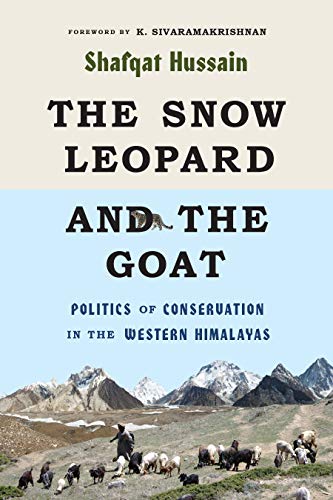One of those obscure books that I can’t tell you why I picked up, but I can assure you I’m glad I read it.

We (urban animal-loving folk) tend to talk about conservation in black and white terms devoid of socio-political content. The book questions this tendency. It reminded me of a quote from Amitav Ghosh’s The Hungry Tide.
“Who are these people, I wondered, who love animals so much that they are willing to kill us for them? …This whole world had become a place of animals, and our fault, our crime, was that we were just human beings, trying to live as human beings always have, from the water and the soil.”
The author goes a step further in The Snow Leopard and the Goat. He says that the conversationist spectacle of free wild animals roaming in vast stretches of wild forest presumes that animals cannot coexist with humans. However, historical data and years of research states otherwise. He points out that the real conflict is not between animals and humans encroaching on their habitat, but urban conservationists and farmers settled near wildlife zones. He writes,
“In Baltistan I have encountered numerous situations in which villagers openly demanded that since people in New York and London want to protect the snow leopards, they should take the animals away with them.”
A key takeaway is that we cannot generalise the behaviour of all animals in the wild. The reasons for tiger endangerment may be different from snow leopard endangerment, depending on the ecological roles, habitats, preferences of that species. The writer argues that the primary reason for the declining number of wild snow leopards is not human encroachment, but hunting and the sale of exotic products like pelts. Snow leopards used to destroy local game animals, and therefore were seen as vermin. These practices were carried out by the same class of social elites that are now proponents of conservation.
Furthermore, there is no use denying that farming has encroached upon habitats. But even here, why does subsistence farming by villagers bear the brunt of the blame? In fact, the majority of habitat degradation is a direct effect of the increased consumption by industrial societies. Yet, we don’t bat an eyelid when entire rural settlements are cleared and rehabilitated to create safe wildlife zones. Either way, villagers bear the costs of our conservation effort. The author discusses how working with the farmers, through schemes like insurance of their livestock, has a better chance of success than “raising awareness.”
The Snow Leopard and the Goat forces you to reconsider assumptions. How are conservation projects marketed? Who are the major donors? When countries work together for conservation, are they really working together? What information do the donors get of the difference they make? Would conservation groups benefit from under-reporting wild animal population numbers? Why not? Why is our idea of the wilderness devoid of humans?
The book douses your conservationist’s passion with some layered facts and references. Not everything the author says rings palatable or unbiased. It’s also a little tedious for someone who isn’t an expert in snow leopards or conservation. But it gives what it promises: a glimpse into the politics of animal conservation. The larger lesson here is: question what information you are fed and whose interest it serves.
You must be logged in to post a comment.